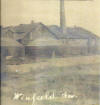Mr. Lyman Beecher Pierce, better known as L.B.,
operated a tile factory at Kossuth, Iowa sometime after the Civil War,
the clay “ran out” there. Mr. Pierce scouted around and found what he
thought was the ideal clay bank at the south east edge of Winfield in
Henry County. He located here and established the Pierce Tile and Brick
works, which did a thriving business. Making tile from the early 1 ½
inch to the 14” used in later years. L.B. operated the yard until his
death in 1921, when the ownership came to his son Mr. Ed Pierce. Up to
this time the tile works was steam operated. The drying shed was a large
three story building. Having an elevator to hoist the green tile from
the cutting mill to the upper dying sheds. Each tile was examined as it
came from the mill, imperfects discarded, others placed on the cart
taken to the drying sheds lifted off the cart one at a time and placed
on the rack to dry. Great care was taken to avoid extreme temperatures,
or sudden changes which caused the “green” tile to crack making them
useless for drainage purposes. Mr. Ed Pierce remodeled the buildings
eliminating the three story structure and using long one story sheds
built over pits or cellars, which made it easier to control temperatures
and humidity. The sheds were connected by rail road tracks upon which
the little cars were pushed hauling the tile from the mill to the sheds.
After the tile were dried properly, they were again placed on the cars
pushed to the kiln. Placed in rows and when the kiln was filled it was
sealed. Then began the last step in manufacture the “burning”, a slow
fire was started in the boxes and heat gradually increased, until about
2100 degrees when it was “shut off” and allowed to cool slowly. A kiln
full of 10,000 white hot tile is truly a wonderful sight. When cool the
tile were again lifted and one at a time, examined for flaws, stacked in
the yards or loaded on wagons or trucks for delivery.
When Mr. Ed Pierce modernized the plant, he installed electricity,
discarding the old steam boiler. The new 40 horse motor made things
easier at the plant, but all progress means loss of some familiar
favorite. Now, no loner did the tile factory whistle say, “Dinner’s
Ready”.
Mr. Ed Pierce operated the tile factory until his death. In 1937, Mr.
J.A. Glass bought the Pierce interests. It was not new to Mr. Glass, as
he had worked here as a boy and at intervals over the years. He was an
expert kiln builder and had taken care of the kilns and stacks for many
years.
Up until 1946, all the clay was dug from the bank by spade. Mr. Glass
bought a Ford tractor with front scoop. Mr. Glass operated the Winfield
Brick and Tile Works until 1951, when his Grandson Eugene Rodruck
acquired ownership. He had returned due to ill health, but never lost
interest.
Eugene operated it until 1957, when it was closed and dismantled.
During its many years of operation it furnished employment to as many as
15 or 20 men during the height of the season. It is almost impossible to
even estimate the number of tile made in the plant during the seventy
five years of operation.
In addition to the millions of tile many brick were made in the earlier
days. Most of the brick for the early business buildings were made here.
I think the oldest one now standing is the Winfield Hotel which is owned
and operated by Mrs. Glass’s Grandson, Ronnie Rodruck.
There are five brick dwelling houses and many hollow tile garages that
have been burned in the old kilns.
So closes a chapter in local history.
~~~~~~~~~~~~~~~~~~~~~~~~
Transcribed and contributed by Pat White, December 2018 |


